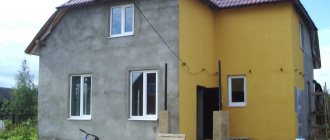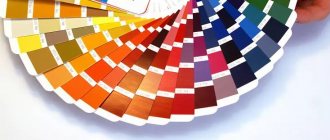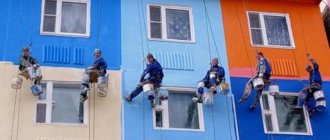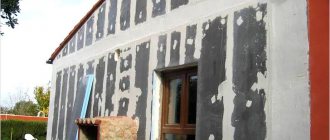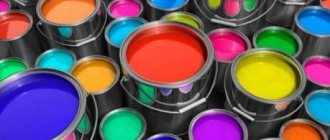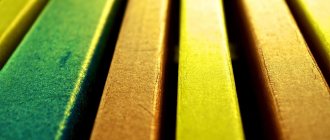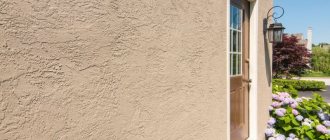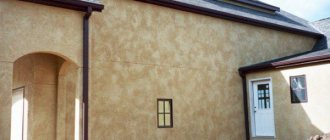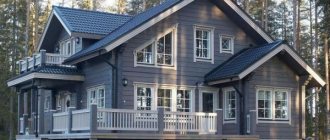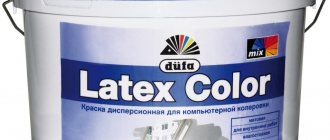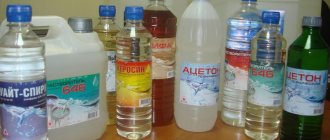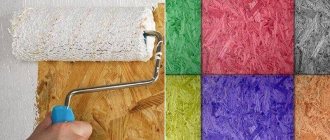In construction, a material such as OSB boards is often used. This product is lightweight and at the same time durable. OSB is also a fairly cheap and accessible material for the construction of various objects and the design of products made from it. In construction, the next stage after the actual construction of the structure is surface finishing. And, like all materials, the particle board must be well prepared for subsequent work with it. The most affordable and easy-to-handle material is considered to be a primer for OSB.
Purpose and application
The main purpose of the primer for OSB slabs is to level the surface, remove imperfections and hide joints. The product also prepares the surface for subsequent decorative finishing, such as wallpapering, painting or laying tiles.
Primer mixtures are used depending on their purpose. There are primers that can be used for finishing interior surfaces, as well as for exterior work.
How to apply primer to OSB
Applying primer to OSB is quite simple. You just need to follow the instructions below.
- Before starting work, it is worth checking the rough surface of the wooden panels and, if necessary, priming them. Once the OSB sheets are installed, they can no longer be reached.
- Next, the protective coating, which was provided by the factory, is removed from the front side of the sheet. This can be done using a special grinding machine to which the P180 attachment is attached.
- After this, the thoroughly sanded slab must be vacuumed to remove dust.
- The primer is thoroughly mixed and poured into a container with which it will be convenient to use. If in the future the slab will also be plastered, then you first need to apply a special absorbent composition; in all other cases, it will be quite enough to use a strengthening mixture.
- The primer can be applied with a roller or small brush. It is worth making sure that no drips or stains form. The composition should be evenly distributed over the surface of the slab.
- After finishing the work, the material is left to dry for at least eight hours.
- After drying, you need to treat the joints between OSB sheets, defects and holes for fasteners with acrylic putty.
A primer for OSB boards will reliably protect the material, make it more durable and improve the existing characteristics several times.
The main thing is to choose a high-quality mixture and apply it correctly to the base.
Composition and technical characteristics
The primer may vary in composition. The following types of product exist:
- Acrylic;
- Alkyd;
- Adhesive.
Important! Before performing work, you must familiarize yourself with each type of product. This will help you choose the most suitable material for OSB boards.
Consumption per 1 m2
When covering a well-prepared surface, the primer consumption per 1 m2 is 1 kg of mixture per 7-14 sq.m. The indicator may vary depending on the composition of the material and the absorbency of the surface.
Plastering on OSB boards inside and outside
One type of finishing is OSB plaster. These boards are wood-based, have high water absorption, and are also unstable to low temperatures (below –30°C). If the frame house has a SIP panel with OSB on the outside, then the walls must be plastered to avoid loss of strength, swelling and deformation of the material. There are finishing and leveling plasters, as well as specialized ones: waterproofing and soundproofing. When the plaster layer is applied, you can use a finishing coating: for exterior finishing, for example, siding, for interior decoration - stone, wallpaper, painting, tiles.
Purchase mixtures that have already been prepared or require dilution. Plaster is also distinguished by purpose: for work inside, outside and universal type.
Is it possible to do this, feasibility
To answer the question whether it is possible to plaster OSB boards, you need to understand what properties the outer and inner putty layers give the surface. Plastering allows the risks of reducing the service life of the slabs to be successfully resolved. This is due to the increase:
- UV resistance;
- moisture resistance;
- vapor permeability;
- fire safety;
- resistance to temperature changes;
- additional thermal insulation and sound insulation.
Owners of private houses have long determined for themselves whether it is possible to plaster OSB boards indoors or outdoors; by plastering the walls, you can forget about repairs for a long time.
Peculiarities
The characteristics of the primer are different for each of the possible types. The acrylic mixture has such individual indicators as:
- This type of material contains acrylic polymers. They are completely harmless to humans and practically odorless. After applying the OSB, within an hour you can stay indoors without fear for your health.
- The mixture is diluted to the required consistency with plain water. Thanks to this, the material is easily applied to the OSB plane, and is also washed off without problems with ordinary water.
- Such mixtures come in different compositions. There are varieties of deep penetration acrylic composition. In addition, some manufacturers add antiseptics, which prevent the formation of mold. This product can be safely applied in damp rooms as well as outside.
- One coat of acrylic primer requires 1-3 hours to dry completely.
Important! Mixtures that are diluted with water cannot be applied at sub-zero temperatures. The water in the primer will freeze and the quality of the OSB surface will deteriorate.
Alkyd mixtures have the following features:
- Makes the OSB surface ideal for applying alkyd paint. This primer is also suitable for varnish coating. It is recommended to use such a product without fail, as it helps to significantly save the amount of paint;
- Helps make the surface stronger, regardless of the local location of the slab;
- This primer for OSB boards has antiseptic properties. A film is formed on the plane of the layer that does not allow water to pass through. Thanks to this, fungus and mold will not develop under the coating;
- A surface treated with an alkyd primer for OSB is not at all afraid of the ingress of various chemicals.
- Alkyd composition is used for processing not only metal and plastic, but also for wooden panels.
Adhesive primer for OSB is almost identical to others. The main feature is the presence of quartz sand in the composition. Due to this, the plane after processing with this material becomes rough.
paints and varnishes
0 votes
+
Vote for!
—
Vote against!
A fairly popular material in construction is OSB, oriented strand board, distinguished by its lightness, strength and affordable cost. But as you know, this production resource requires additional finishing, which allows the owners to realize the most extraordinary ideas in the design of buildings. Therefore, many non-specialized craftsmen have questions about what paint to paint an OSB board, what coatings to look for and what you need to know about them? More on this later in the article.
Table of contents:
- OSB - material features
- Is it possible to paint OSB?
- Stages of preparing the OSB surface for coating with paints
- Paint for OSB boards indoors
- Paint for OSB boards outside
OSB - material features
OSB is a material that consists of wood chip elements that are bonded together with waterproof synthetic resins. For their production, pressed equipment is used, which makes it possible to form slabs of three or four layers. In construction, OSB is used for different purposes, they are suitable for:
- construction of frame houses;
- indoor wall and ceiling cladding;
- installation of formwork;
- manufacturing of structural furniture elements, etc.
When properly manufactured, finished slabs are considered an environmentally friendly and safe product, which comes in several varieties. So, there are four OSB formats:
1. OSB-1 is characterized by low strength and moisture resistance, which is why this brand is most often used in the process of making furniture and carrying out interior work.
2. OSB - 2, with high strength indicators, is characterized by low moisture resistance, so this board is suitable for the production of partitions, etc.
3. OSB grade - 3 is a fairly durable and moisture-resistant material that is actively used in organizing external construction work.
4. OSB - 4 is considered the best resource in this category, due to its maximum moisture resistance, it is used to create roofs, walls of buildings, load-bearing elements, etc.
The strength and moisture resistance of the material depends on what percentage of the adhesive was used in the production process, as well as on the number of layers of pressed chips. As for the sizes of the slabs, they are standard: 122*244 cm, 122*336 cm, 125*375 cm, etc.
It is worth noting that oriented strand board has a low fire hazard and is not subject to processes such as rotting, delamination, and mold development. Its technological characteristics in many cases are superior to such wood resources as chipboard, plywood, and fiberboard. In addition, this material protects buildings well from excessive sounds, does not deform when in contact with water, and perfectly retains heat in the room.
Structures made from pressed slabs have a long service life. According to the recommendations of experts, owners buying OSB should check the certificates of construction products, since it is worth taking into account the fact that phenol, which is part of the resins, can harm human health, and its safe alternative, formaldehyde, is a worthy option. Therefore, it is better to buy materials with the Eco mark. Some of the world's worthy OSB manufacturers include the following brands:
- Norbord;
- Egger;
- Ainsworth;
- Glunz;
- Grant, etc.
It is worth noting that Chinese manufacturers offer products at a low price, but their quality is only suitable for external use.
Is it possible to paint OSB?
On the construction market, of course, there are oriented strand boards that are pre-coated with paint and varnish, but their cost is much higher than the pure resource. But still, most often, owners purchase those sheets that require additional processing during the process and for this purpose they use various varnishes, paints and other similar means that allow them not only to extend the service life of OSB, to add harmony to the appearance of the building, but also to hide unevenness chip texture of the material. Paint for OSB boards, the choice of which is based on several important rules, can be of any color, the main thing is that it does not contain harmful pigments. So, see the table for the types of coatings.
| Types of paint coatings | ||
| oil | acrylic | alkyd |
| This variety is considered an ideal option for painting OSB, due to the high level of viscosity of the product. This allows the coating to lie flat on the surface of the slab and not be strongly absorbed into the wood texture itself. The disadvantage of this type of painting is the long drying period, but this does not mean that the result will be bad. Oil paints allow you to obtain an impressive protective layer. | Painting OSB slabs with acrylic paint is considered a very profitable option, since this type of coating does not require additional finishing and allows the slabs to serve their owners for a long time. These products carefully hide irregularities in the chip material and create even color tones. If acrylic coating is provided on external walls, it reliably protects the wood from mold. | Alkyd enamels are a coating that penetrates deeply into the OSB structure, resulting in a high-quality, durable finish that significantly extends the service life of pressed boards. |
Various antibacterial impregnations are also actively used for processing OSB, which makes it possible to give the material a tinted effect. It is worth saying that in order for an OSB board painted with paint to look natural and not lose its original characteristics, it is necessary to take into account the characteristics of the wood resource, composition, base of the coating and properly prepare the surface for processing.
Stages of preparing the OSB surface for coating with paints
If you apply paint directly onto the wood board itself, without pre-treatment, the material may swell and lose its ideal original appearance. Finishing and painting construction resources is a whole technological process in which, in order to achieve ideal results, it is necessary to act in stages. So, before purposefully using paint, it is necessary to prepare the OSB surface.
1. To ensure that the wood material does not absorb excess primer and paint, you need to grind the surface, which will smooth out uneven textures. At this stage, the master will need a special tool - a grinding machine. Particular attention should be paid when sanding boards of grades 3 and 4. If the OSB does not show any special violations in the structure, then you can get by with ordinary sanding paper.
2. At the next stage, they work with places that form rough irregularities on the slabs, most often these are joints, areas where screws are used, etc. To do this, craftsmen introduce special oil-adhesive compounds, putties, decorative strips, etc. into the work process.
3. The next working stage involves applying the primer layer. To do this, you will need varnishes with an acrylic or acrylic-polyurethane composition. Wide brushes are best for applying it. The product must be applied evenly over the entire area of the slab, slowly.
4. Paints for OSB boards can be purchased at any hardware store, after which it is recommended to work with them using generally accepted technology. The essence of working with such products is to apply several layers, while their density increases in the area of \u200b\u200bthe edges. It is worth considering that the movement of the brush should be performed in one direction. The slab panels must be dried at a stable temperature, strictly neutralizing drafts.
It is necessary to remind the following nuance that for alkyd enamels the painting stage is considered the last, since they do not require additional finishing. But in the case of oil and acrylic, a varnishing process is also added, which allows you to obtain the most durable surface.
Paint for OSB boards indoors
As practice shows, a wide variety of materials are used to paint a room from the inside. And this is not prohibited, the main thing is that the owner is confident in their safety, and for this he must request the appropriate quality certificates when purchasing, and also be interested in the composition of paint products. Also, when choosing a coating, it is worth considering the time that the owner has to carry out repair work. After all, as you know, for example, oil paints are characterized by the property of taking a long time to dry, but are considered a worthy option for decorative finishing of a room.
In comparison, alkyd enamels dry quickly and do not require additional varnish treatment, which means that this product is suitable for those who want to quickly finish the interior decoration of rooms. Painting an OSB board indoors with acrylic paint results in a surface that can be both cleaned and washed. It is not recommended to use ordinary water emulsion for finishing OSB. For oriented strand boards, products based on organosoluble pigments are best suited.
In the process of painting pressed wood material, craftsmen will need tools such as brushes, rollers, and spray guns (to perform a large amount of work). Before spreading the paint material around the entire perimeter, it is best to first paint a small area of the slab, evaluate how smoothly the chosen product lays down, when purchasing which you need to clarify whether it is suitable for wooden surfaces. When additional treatment with varnish compositions is applied, applying several layers, it is necessary to maintain a time period of at least 12 hours. It is also necessary to say that paints are applied to the OSB surface in unlimited layers until a 100% monochromatic effect is obtained.
Paint for OSB boards outside
Facade paint for OSB boards can also be of a varied nature. Along with oil, acrylic and alkyd coatings, products containing latex polymers can also be used. Products containing alkyd resins are characterized by good waterproof and rust-resistant properties. It is paints from this category that will be able to reliably protect OSB from the outside, since they are characterized by frost resistance, low abrasion, etc. Equally important is the low toxicity of this dye. If the master decides to use alkyd paints, he has the opportunity to choose colors from a wide range of matte and glossy enamels. It is worth remembering that it is recommended to apply this group of paints to a dry, clean wood surface.
No less in demand for external OSB treatment are acrylic products, the distinctive feature of which is the high level of water in the composition. They are absolutely practical and, when used and applied correctly, do not actually cause swelling of the slab. This type is recommended to be applied slowly, in small quantities, this will allow the water molecules to evaporate faster. It is worth noting such facade materials as silicone water-based compositions, because their advantages are considered to be: anti-flammability, vapor permeability, as well as a high level of adhesion, in addition, most of them are characterized by antibacterial properties.
Thus, we can conclude that the choice of paint material for OSB is a choice that strictly concerns the owners, based on the available budget and the purpose of the construction project. The main thing is for craftsmen to remember that OSB is still a raw wood resource that requires special care and should not be subjected to unnecessary exposure to high levels of moisture. Therefore, any oil, acrylic, alkyd and other compositions, if properly selected and applied, will be good protection for a structure made of oriented strand board. For more information on the topic, watch the video:
Advantages and disadvantages
Primer mixtures for OSB have the following advantages:
- Safe;
- Well levels the surface of the slab and isolates it from external negative influences;
- Protects against the appearance of fungus and mold;
- Dries quickly;
- Can be used for finishing surfaces indoors and outdoors;
- Whitens the slab well;
- Reduces the consumption of glue or paint for subsequent finishing.
Among the disadvantages, it is worth noting that not all types of primers are safe until completely dry. Also, the drying time may vary depending on the composition of the product, as well as on indicators such as temperature and humidity of the room.
Why paint OSB boards?
First of all, you need to decide whether further wall cladding will be done, or whether painting will be used as a finishing coat.
If you plan to cover the walls with siding, clapboard, polystyrene foam and insulation, the slabs can simply be treated with compounds that prevent the development of fungi, mold, and rotting. In this case, you can apply a multicomponent emulsion to the wall, then coat it with a primer. Any cheap acrylic compounds or varnishes are used for cladding.
If painting is a finishing touch, you should choose a quality paint. She must have the following qualities:
- attractiveness;
- resistance to fading, snow and rain;
- protective properties against sunlight;
- resistance to mechanical stress.
You can use surface priming as a finish. To do this, use a regular transparent primer or a mixture with the selected color. OSB can also be primed for other finishes.
Preparing the surface for further decoration
Before you begin the actual design of the surface, it is necessary to carefully prepare it. The technology for pre-treatment of surfaces may differ depending on the type of material that is planned to be used in the future.
Under wallpapering
You shouldn’t just glue wallpaper onto bare OSB boards. You must first do the following:
- Using putty, attach the mesh to the joining seams. It will make the slab level and all hints of joints will disappear.
- Dilute the OSB primer according to the instructions and apply an even layer. Allow the material to dry completely.
- Once the primer is dry, you need to apply the putty as evenly as possible. Let this product dry too.
- When the putty has completely adhered to the surface, it must be processed using sandpaper. This will make the surface smoother.
- Next, you need to make another layer of OSB primer and make sure that the surface is smooth without protruding elements. If they are present, such as small pieces of primer sticking out of the wall, then they should be removed with sandpaper and another primer coat done.
- After the surface has completely dried, you can decorate the particle board with wallpaper. Wallpaper is glued in the usual way.
Important! Applying a primer for wallpapering on OSB is a must. The fact is that this product will provide good adhesion between the wallpaper and the wall.
For painting
Simple painting of slabs always ends with uneven application of the paint material and the presence of visible stripes. This can easily be avoided if you do the following preliminary work:
- Cover all joints with putty or seal with foam. After drying, the foam needs to be cut off so that it becomes flush with the plane.
- Apply a layer of putty to the surface. This will help completely hide all the joints.
- If the wall is not planned to be textured, then it must be sanded well. Then apply a layer of primer, carefully ensuring uniform application. For a better effect, it is recommended to do two layers of primer.
- Paint the wall with a roller. It is important to apply paint to the entire surface area at once. If you interrupt during work, some areas will dry faster. And you will get stripes.
Advice! To avoid streaking, it is recommended to apply two coats of paint. The first one will simply create the color. The second one can level it.
Using the same principle, you can paint and prime the ceiling and walls.
Under the tile
The tile will adhere well only to a pre-treated surface. Bare application will cause the tile to peel off from the plane. To prevent this from happening, it is enough to cover the surface with two layers of primer mixture for OSB boards.
You may not achieve perfect application and leveling of the surface. The main thing is that the tile has something to cling to. It is recommended to pre-cover the joints with putty.
Application of OSB
Recently, due to the unique properties of their properties, oriented strand boards (OSB, OSB or OSB) have begun to gain widespread use. In the construction industry, OSB is used when performing the following work:
- Flooring. Since OSB has a durable and smooth surface, it can be laid on a concrete base and subsequently covered with linoleum, tiles or laminate. Also used as a subfloor. OSB is also used for pouring self-leveling concrete mixture.
- Serve as internal partitions. In the future they can be covered with any type of paint or wallpapered.
- Used as external walls or partitions. Next, they are lined with materials for external coatings.
- Since OSB is a strong material, it can be used as a continuous roof sheathing. Can withstand heavy snow loads.
- Furniture manufacturing. The only limitation applicable to OSB products is the absence of direct contact with water.
- Manufacturing of containers.
OSB-3 is the most widely used on sale due to its versatility in use. Sandwich panels for the rapid construction of houses are made from the same type of material. The surface of such OSB panels is coated with paraffin or wax, imparting high water-repellent properties to these products.
However, because of this, simply painting the OSB panel will be problematic. The paint, not having an adhesion to paraffin, will drain. Wallpapering without preliminary surface treatment can also end in bad results.
Tips and recommendations for use
When working with OSB primer, you should rely on a single correct algorithm for applying the material to the surface. It looks like this:
- Surface cleaning. Before applying the primer, the slabs must be thoroughly cleaned of dust and dirt. It is advisable to walk with a slightly damp cloth over the entire surface of the OSB.
- Sealing joints osb. The joints can be sealed either simply with putty or with acrylic sealants. Quite often, polyurethane foam is used for these purposes. In any case, after the product used has dried, its excess is cut off or sanded with sandpaper.
- Preparing the mixture. The primer composition must be thoroughly stirred before use if it has already been prepared. If it is a dry mixture, it must be diluted with water in accordance with the instructions.
- Applying primer to osb. From the very beginning it is worth treating all joints with the composition. Then apply two layers of primer. It is important that several hours pass between applying layers, during which the first layer can dry.
Using the same algorithm, you can use a primer layer for OSB panels on the outside.
It is also worth paying attention to the importance of mixing the primer immediately before application. This is especially true for the adhesive type. This mixture contains quartz sand, which, as a rule, precipitates when the mixture sits for a long time.
Features of OSB taken into account before painting
When deciding how to paint an OSB board outdoors, you need to carefully study the requirements that apply to the coloring composition in this case. They are related to the characteristics of the material that requires processing. When choosing, you should consider the following nuances:
- Poor adhesion of the surface of OSB boards. Due to the fact that the material is initially impregnated with resins, the paint is absorbed extremely poorly. Therefore, you should not buy water-based formulations. It is better to give preference to acrylic paints or other polymer paints;
- The surface of OSB boards has a pronounced textured surface. On the one hand it looks beautiful, but it is extremely inconvenient to handle. Irregularities and roughness contribute to increased consumption of painting material; the surface requires treatment before painting;
- Age of the material. This is an important factor; the older the slab, the more difficult it is to protect it. If immediately after installing OSB the surface was not treated with a protective coating and was exposed to negative factors for a year, then its quality will greatly deteriorate.
Unprotected slabs quickly lose their attractive appearance, age, and the surface becomes even more defective. Therefore, when processing such materials, additional surface cleaning, grinding, treatment with antiseptic agents, and then painting are required.
Review of popular manufacturers
Among the manufacturers of primer mixtures for OSB, the following are noted:
- Master Inter. This is a universal primer. It can be used not only on wood, but also applied to concrete bases. Well suited for painting and wallpapering. It gives not only an attractive appearance to the surface, but also acts as a binding layer for subsequent finishing.
- Kreisel 301. This primer mixture is universal and suitable for almost any surface, in particular OSB. It belongs to deep penetration materials. Thanks to this, the layer is smooth and sits well on the surface.
- Moment GROUND. A universal primer mixture that fits well on OSB boards. After hardening, tar stains will not appear on its surface, which happens with the coating of wooden surfaces.
- GF-21. Special primer for wooden surfaces. This product performs all the standard functions of a primer, and also additionally protects the OSB surface from fire.
Types of primer according to composition that are suitable for priming
If you use OSB board correctly, it can be used for a long time and cope with the assigned tasks perfectly.
In order to improve the characteristics of the material, it is worth using a special primer. Today, no universal composition has yet been invented that could solve all the problems at the same time. The final choice of primer will depend on the conditions in which the material is used and what kind of finishing coating will be present.
Acrylic primer
The acrylic primer contains water-soluble components. You can find two types of acrylic primer on sale - penetrating and strengthening. It is worth choosing the appropriate type taking into account what kind of finishing will be used in the future. This material is popular among buyers because it has many advantages.
The main ones include the following:
- Easily washed from different surfaces.
- Completely safe for human health.
- Due to the presence of several different modifications, you can choose the most suitable option.
- Easily tinted in any color and can act as an independent finishing coat.
- It has a very affordable price.
- It dries very quickly, so repair work does not take much time.
- Protects the surface from excess moisture.
- It can act as a good antiseptic and protects against mold and mildew.
- It lends itself well to grinding, which allows you to obtain an ideal surface without unevenness or defects.
To process OSB boards, it is best to use a strengthening mixture that has a light milky color. In the event that liquid wallpaper is applied or puttying is carried out in the future, it is worth applying a layer of penetrating primer.
Alkyd primer
The alkyd primer contains dissolved resins, which makes the material a really good example of protecting the surface being treated.
In addition, products of this type have some other important characteristics.
- After drying, a polymer film is formed, which is excellent protection against ultraviolet radiation and precipitation.
- Has a high level of resistance to chemicals.
- Penetrates quite well into the OSB board, which allows increasing the adhesion rate.
- It can be easily tinted to any desired color and can act as an independent finishing coat.
- Saves the consumption of finishing materials by about one and a half times.
- Makes OSB sheets more durable and increases their service life.
At the same time, this type of primer also has several major disadvantages. The mixture can be used exclusively for outdoor work due to its fairly high toxicity rating. If you stick wallpaper onto such a mixture, it will be almost impossible to remove it.
Adhesive primer
Adhesive primer allows you to make OSB sheets more durable, increases their service life, and penetrates inside quite well, filling all the pores. It is an excellent option for working with a wide variety of finishing materials.
